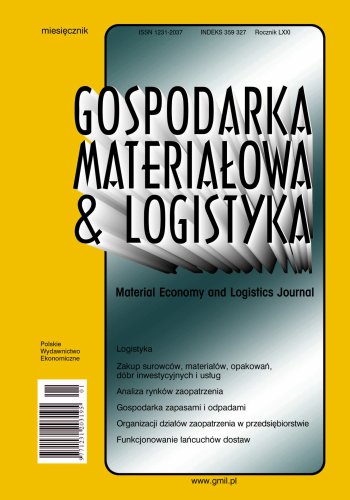The use of machine learning methods to predict the risk of damage to goods
The transport demand is increasing year by year. This is because of the increase in production and consumption. The longer the supply chain is, the more likely it is to be disrupted, as all operations involve risks. However, risk in the context of the supply chain and its management has recently been discussed. Unfortunately, no industry is immune to predictable and unpredictable disruptions that affect losses (e.g. loss of goods). From the point of view of carriers, it would be important to be able to predict the occurrence of, for example, damage to the goods. The article focuses on the use of machine learning methods to predict the risk of damage to goods (such as electronics, household appliances or telephones/computers) in road transport. The research used five intelligent methods such as: logistic regression; support vector machine (SVM); decision tree; naive Bayesian classifier; AdaBoost. The aim of the paper is to present the concept and the above-mentioned methods of machine learning, measures assessing the performance of models and the results related to the conducted research. The set goal determined the choice of the research methods – literature analysis and programming were used. The last part of the article presents the results obtained from the analysis of five models. The research established that AdaBoost has the best predictive ability.
References
Bibliografia/References
Anholcer, M. (2017). Optymalizacja przewozów produktów szybko tracących wartość – modele i algorytmy. Wydawnictwo Uniwersytetu Ekonomicznego w Poznaniu.
Baryannis, G., Dani, S., & Antoniou, G. (2019). Predicting supply chain risks. Using machine learning: The trade-off between performance and interpretability. Future Generation Computer Systems, 101, 993–1004. https://doi.org/10.1016/j.future.2019.07.059
Baryannis, G., Validi, S., Dani, S., & Antoniou, G. (2018). Supply chain risk management and artificial intelligence: State of the art and future research directions. International Journal of Production Research, 57(7), 2179–2022. https://doi.org/10.1080/00207543.2018.1530476
Cunningham, P., Cord, M., & Delany, S. J. (2008). W: M. Cord, & P. Cunningham (Red.), Machine learning techniques for multimedia.
Cognitive technologies (21–49). Springer. https://doi.org/10.1007/978-3-540-75171-7_2
Biazon de Oliveira, M., Zucchi, G., Lippi, M., Farias, C., Rosa da Silva, N., & Iori, M. (2021). Lead time forecasting with machine learning techniques for a pharmaceutical supply chain. Paper presentation. Proceedings of the 23nd International Conference on
Enterprise Information Systems on International Conference on Enterprise Information Systems (ICEIS). 26–28.04.2021. https://www.scitepress.org/Papers/2021/104344/104344.pdf
Dridi, S. (2021). Unsupervised learning – A systematic literature review. https://www.researchgate.net/-publication/357380639_Unsupervised_Learning_-_A_Systematic_Literature_Review (pobrano 22.09.2022).
Drucker, H., Donghui, W., & Vapnik, V. N. (1999). Support vector machines for spam categorization. IEEE Transactions on Neural Networks, 10(5), 1048–1054, https://doi.org/10.1109/72.788645
Iwendi, C., Mahboob, K., Khalid, Z., Javed, A. R., Rizwan, M., & Ghosh, U. (2022). Classification of COVID-19 individuals using adaptive neuro-fuzzy inference system. Multimedia Systems, 28(4), 1223–1237. https://doi.org/10.1007/s00-530-021-00774-w
Joachimiak, K. (2016). Zastosowanie technik uczenia maszynowego w przetwarzaniu języka naturalnego [praca magisterska, Uniwersytet im. Adama Mickiewicz w Poznaniu]. https://zpjn.wmi.amu.edu.pl/wp-content/uploads/-2019/04/praca-magisterska.pdf
Laska, J. (2019). Przegląd metod uczenia maszynowego stosowanych w analizie wydźwięku [praca magisterska, Uniwersytet im. Adama Mickiewicz w Poznaniu]. https://zpjn.wmi.amu.edu.pl/wpcontent/uploads/2019/10/praca_magis-terska_justyna_laska.pdf
Mittchel, T. (1997). Machine learning. McGraw-Hill Education.
Sartias, M. M., & Yasar, A. (2019). Performance analysis of ANN and Naive Bayes classification algorithm for data classification. International Journal of Intelligent Systems and Applications, 7, 89–91.
Schober, P., & Vetter, T. R. (2021). Logistic regression in medical research. Anesthesia and Analgesia, 132(2), 365–366. https://doi.org/10.1213/ANE.0000000000005247
Schroeder, M., & Lodemann, S. (2021). A systematic investigation of the integration of machine learning into supply chain risk management. Logistics, 5. https://doi.org/10.3390/logistics5030062
Su, J., & Zhang, R. (2006). A fast decision tree learning algorithm. W: AAAI'06: Proceedings of the 21st national conference on Artificial intelligence, 1, 500–505.
Waters, D. (2007). Supply chain risk management: Vulnerability and resilience. The Chartered Institute of Logistics and Transportation.
Wenzel, H., Smit, D., & Sardesai, S. (2019). A literature review on machine learning in supply chain management. Artificial Intelligence and Digital Transformation in Supply Chain Management: Innovative Approaches for Supply Chains, 27, 413–441.
Visa, S., Ramsay, B., Ralescu, A. L., & Van Der Knaap, E. (2011). Confusion matrix-based feature selection. W: Proceedings of The 22nd Midwest Artificial Intelligence and Cognitive Science Conference 2011, 120–127.
Wyrembek, M. (2022). Wykorzystanie technologii Big Data do predykcji ryzyka opóźnień w łańcuchu dostaw. Gospodarka Materiałowa i Logistyka, 6, 29–36, https://doi.org/10.33226/1231-2037.2022.6.4
Zhu, J., Zou, H., Rosset, S., & Hastie, T. (2009). Multi-class Adaboost. Statistics and Its Interface, 2, 349–360.

